
|
Bidston Village, Church, Hall, Hill & Mill
Origins: Bediston 1260, Byddi’s farm or Budda’s town. But can also
originate from bytle stan (dwelling on a rock),
|
|
|
Village Buildings
The Mill
The
Hill
The
Hall
Flaybrick Cemetery
Bidston Aerodrome
History |
|
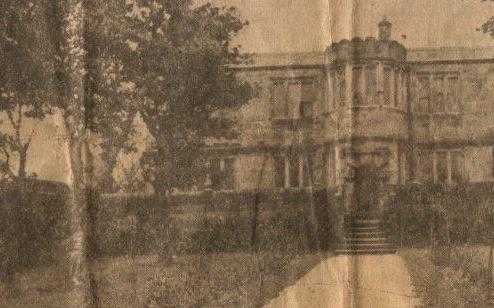 Bidston Hall - more on the Hall here |
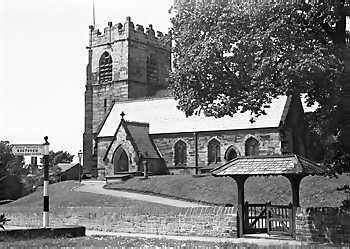 St Oswald's |
|
Nestling at the edge of the Birkenhead boundary, and just before you pass down Fender Lane to arrive in Moreton, lies the hamlet and ancient village of Bidston. Or "Biddy" as we knew it. As a child in the late 50s early 60s, this was an enchanted world of ancient buildings, a "magic" village shop, and seemingly miles of woodland. Nowadays it fights to survive, to retain its identity, in the sprawling midst of urban decimation of the landscape in the form of council and private housing. Although the Council is bound by decree and law to uphold the Hill for the public, they are allowing houses to creep closer and closer. The threat to this time capsule dot on the map is complete and utter annihilation and all that will be left of it is a "name" on a map. I can only hope that the council of Birkenhead can find both the time and the money to protect this most ancient of places for us and future generations to admire. The village shop was, I believe, held within a converted barn on the "main street". The shop door was large, heavy wooden, heavily studded and today would be worth a kings ransom. Oh how it was all taken for granted, and now is almost lost without trace, so very sad. |
Sandwiched between council housing developments
and sliced through the middle by a busy main road the tiny, centuries old, village
of Bidston hangs grimly onto survival.
So started a newspaper article from 1970. Since then the village has been
isolated by the building of a bypass which takes the main, very busy, road from
Birkenhead, west around Bidston Village, to Moreton and beyond. The article
continues: Like a flashback into the
past it straddles the main road to Hoylake barely a couple of miles from the
depression of Birkenhead. But the lovely old cottages and farmhouses, their
fields increasingly being taken away for housing, are falling into disrepair,
thatched roofs are wearing thin. And nobody, it seems, are prepared to take the
necessary action to preserve the village gem whose history goes back centuries.
But one man who does care, and who is determined that the neglect of Bidston
shall end, is Mr Maxwell Faulkner, architect turned businessman, who, a few
years ago, rebuilt Bidston Hall (see above) from
its ruins into the beautiful property it is today. (On 4th
February 2009 I took a walk along the footpath alongside the war memorial and
was surprised to see that the council estate now actually touches the rear of
the Yew Tree & Ivy cottage properties. Their rear view is now of modern brickwork
and tiled roof.) |
|
|
Mr Faulkner said yesterday "The absolute first vital essential is that the village must be made into a conservation area under The Town And Country Planning Act so that the buildings cannot be pulled down for any reason. He wants to see Birkenhead Corporation take the initiative in this to conserve for future generations as an outstanding asset to the town, properly and sympathetically restored. He also wants the area of the village clearly defined, with more tree planting, all designed to cut down the vandalism which is the backlash of the new estates. (This will be the Ford Estate which now (2003) virtually swallows everything in its path) A bypass is already planned as part of the new motorway system (already done and dusted) but Mr Faulkner believes that until the present road is completely closed up the village concept can never be fully achieved. (I recently stood on this road trying to take photographs but kept having to "run" for the kerb due to the volume of traffic - 2004) He estimates £20,000 as the amount needed. One of the village residents, Mrs Margaret Parkinson, of Ivy Farm (her husband, with no land left to farm, is the local golf club green keeper) has a photograph taken only 16 years ago, of cattle walking along the road outside the house. Now, at the rush hour and most other times, the residents can barely cross the road, traffic does pass through rather quickly! On the skyline are the tower blocks of corporation flats as the estates come closer. The latest development for which road works are already completed will come to within a few hundred yards of the village. (This is now the Ford Estate). Mr Faulkner says frankly that he does not believe the local authority care about the village. Although Mr A Thelwell, the Deputy Town Clerk, denies this and says that "a survey of the old houses is now going on with a view to putting preservation orders on them depending on condition". Mr Faulkner says this was done in 1961 without any resulting action. "I want the owners, the local authority, and the residents to get together at an initial meeting to get to grips with the reality of the problem." Soon he is moving his business interests to the south, "Before I go I want to finish off the job with the Hall", Mr Faulkner says. A perfect example of what Mr Faulkner was saying about the incursion of estates upon the village scene. This was all fields and old buildings in the 60s, beyond these houses there runs the M53 motorway, then more houses as the eye approaches Moreton in the distance at Reeds Lane. The area around Bidston is virtually unrecognisable from my own youth and to see such a magical, time locked, village vanish is painful. A preserved Bidston would have been a jewel in Birkenhead's crown such as the Black Country Museum is in the Midlands or Haworth in Yorkshire. It is not too late, but very nearly. |
| The manor of Bidston, a township in Cheshire, and the entire parish, were formerly part of the barony of Dunham Massey, and continued in the possession of the lords of Dunham for about a century and a half, when they came into possession of Henry, Duke of Lancaster, He afterwards gave them, with other lands, to Roger de Strange, Lord of Knockyn, in exchange for lands in Lincolnshire; and they continued in possession of this family until about the reign of Henry VI, when the manor of Bidston passed to the family of the Stanleys, (*See note below) Earls of Derby, who held them until 1653, when they were sold by Charlotte de la Tremouille, Countess of Derby, and her son Charles, Earl of Derby, to William Steele, Esq., a commissioner-at-law, by whom they were resold, in the reign of Charles II, to Lord Kingston, an Irish peer, and some years afterwards the property was again sold to Sir Robert Vyner, lord mayor of London. Bidston Hall stands on a commanding situation on a rock of yellow freestone, of which material it is built. The western front has bay windows and projecting gables, and the entrance is in the centre of the front, formed in a semicircular porch, which rises the entire height of the building. The eastern side corresponds with the western, but has in addition a piazza along the lower storey. The front approach Is through a square court, with a handsome gateway having a singular arch highly ornamented with the cognizances of the Derby family. In some intermediatory purchase it is said Bidston Hall was won and lost at cards, to commemorate which a summer-house was built in the form of a club, as usually represented in that card, the foundations of which still remain in the picturesque grounds attached to the hail.— See Mortincer’s History of the Hundred of Wirral. |
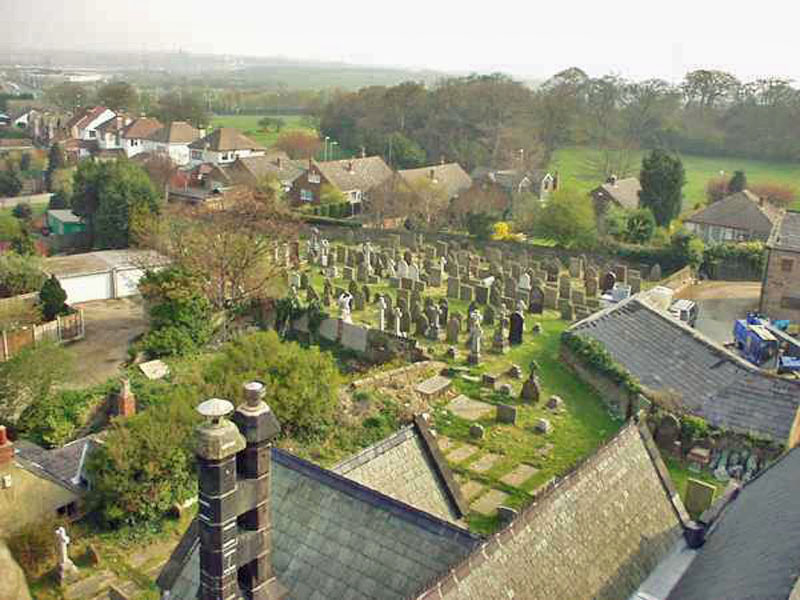 A View from the church tower and below |
|
The Hall was built by William, 6th Earl of Derby, it is believed, in 1595 or 1620, and now restored, stands as an example of what could more easily be done to the group of three and four centuries old buildings around the parish church 200 yards away. Mr Faulkner has now, at his own expense, produced a 50 page survey of Bidston, telling its history, its present problems, and his recommendations for a permanent solution. Called "An Appeal For Survival" (published at the end of January 08?) and copies be sent to the village owners - all but the hall is settled in a family trust - Birkenhead Corporation, The Ministry of Housing & Local Government, the Society For The Protection of Ancient Buildings, the Civic Trust and other bodies, in an attempt to force action before it is too late. The village passed into the hands of the VYNER family in the 17th Century, and is now administered as a family trust. The present head of the family is Cdr C G VYNER who lives in Sawley, Yorks. He told me "I think, in theory, one wants to preserve as much as possible, but with the surrounding development, one must face facts as they are (I suspect he didn't give a damn in truth) When you have a place like Birkenhead on the doorstep there is a limit to what you can do. Cdr VYNER said that some years ago he had presented the Rhododendron Gardens to Birkenhead Corporation to act as a buffer for the village on the condition that they were maintained in the same beautiful condition. Now they are a neglected wasteland used as a playground by children. Naturally I would like to see the village as it was but these things are taken out of one's hands." (There has been much work in restoring the rhododendron's to something resembling order. - mk 2008 - On Feb 4th 2009 I drove down Boundary Road and there is much evidence of the bushes being stripped back, but looks "messy"). |
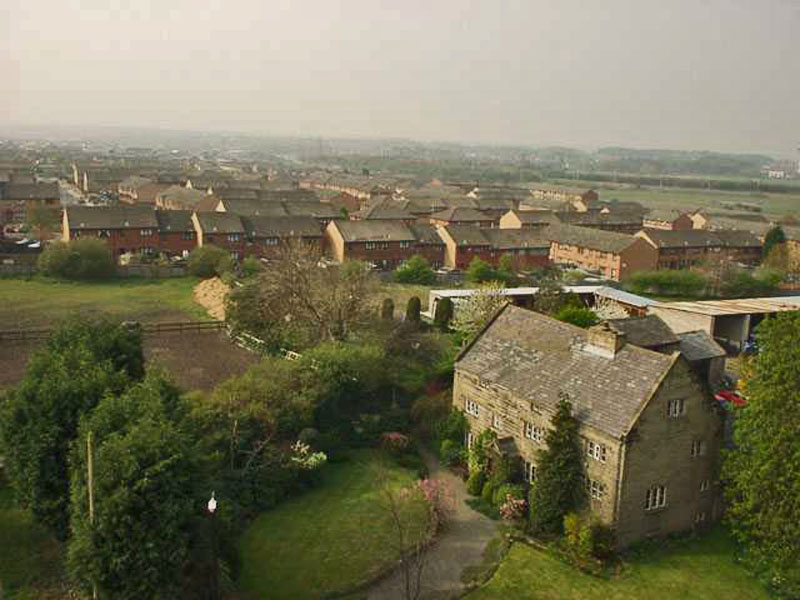 |
|
Bidston Village has appeared in records since Doomsday, but evidence for occupation goes back to the Stone Age. The Village still maintains its medieval shape of church, farms, village green and manor house. The Village has a rich heritage, and has been involved in several key points of British history. At one time, the village was owned by the Stanley family, who became Earls of Derby. The 6th Earl of Derby has been closely associated with William Shakespeare and is credited with bringing Shakespeare to Bidston as a member of a band of actors. As Royalists, the Stanley family forfeited their lands during the Commonwealth, but on the Restoration of the monarchy the village came into the possession of the Vyners family. It is because of the Vyner family that the village has remained in the style of a Medieval village, and in the late 20th century was designated as a Conservation Area. It is known that a church was in existence in Bidston when Birkenhead Priory was founded in the middle twelfth century. The church was re-built about the middle of the thirteenth century and the tower added in 1520. This is the tower which still stands today and which is the only part of the present-day church dating from before 1856, when a further rebuilding took place, the previous structure having fallen into disrepair. It is likely that the tower contained bells in the sixteenth century and that these were replaced by a ring of three cast in 1615. One of these is said to have come originally from the Shrine of St Hildeburgh on Hilbre Island, which lies off the north-west tip of the Wirral Peninsula at the north end of the Dee Estuary. These bells were replaced by a ring of five, cast by Mears and Stainbank, in 1868. The treble was added in 1882. The present dedication of the church - Saint Oswald - arises from an inscription on one of the old bells. The original dedication was not known and it was assumed from this inscription that the patron saint was Oswald. The church was therefore formally dedicated to Saint Oswald in 1882. However, since the bell in question had actually been brought from St Oswald's Church in Chester, it appears that the assumption may have been unfounded. The church lies in the heart of the village of Bidston and can be approached from one of two directions. Travelling from Birkenhead in the east, the visitor passes Bidston Hill and Observatory and descends to see the church at the bottom of the hill, sitting on a steep grassy bank and surrounded by farm buildings - a prospect which has remained largely unchanged for over a hundred years. From the south-west, the tower is visible for a mile or so from the road which runs alongside the area now known as Beechwood and which was named the Ford Estate when it was built in the early 1970s to re-house the inhabitants of the North End of Birkenhead when a large number of houses were demolished. It was the creation of the Ford Estate which significantly altered the nature of the parish of Bidston. The parish boundaries originally encompassed a large part of North Wirral - Moreton, Saughall Massie, Claughton and Birkenhead, as well as Bidston itself. Bidston became separated from its smaller townships at the beginning of the nineteenth century, when Birkenhead was boosted by the flourishing sea trade and effectively became a suburb of Liverpool. In 1801, Bidston had 199 inhabitants and Birkenhead 110. By 1831, Bidston's population had risen only gradually to 252 while Birkenhead's had mushroomed to 2,569. With the contracting of its boundaries, the parish, although still covering a large area, retained its rural character - a character which still prevails today in the centre of the village. Bidston Hall, Church Farm and Yew Tree Farm all date from the seventeenth century; across the road from the church is Stone farm, which was formerly the Ring o' Bells Inn with a swinging signboard depicting the ringers at work. Unfortunately, the last landlord, Simon Croft, was also one of the inn's best customers and did little to discourage drunken behaviour, which distressed the churchgoers and led to the inn being closed down in 1868. This left the village without any licensed house for more than a century. The twentieth century has seen various housing estates spring up throughout the parish - Birkenhead North End, part of Noctorum, Ballantyne and Beechwood. The population of the parish now numbers some 10,000. The presence of these housing estates persuaded the church to reconsider its role of ministry in the community. The parish hall having been destroyed by fire, there were few facilities for the parish population, and it was decided to redesign and refurbish the interior of the church so that it could be used for community activities. This was completed in 1988 at a cost of £120,000. At the time of writing, the Community Project is celebrating its tenth anniversary. The church has had a stable band of ringers almost continuously since the inception of the Chester Diocesan Guild in 1887, though little is known about the ringing before that date. A notable figure was William Wilcox, who learned to ring in 1883 and took over the tower captaincy in 1889, a position which he held until 1931. He conducted the first peal at Bidston by a local band in 1911. Mr Wilcox and his wife ran a sweet and tobacco business from their thatched cottage in School Lane which had once been the village school - sadly, it was destroyed in the Second World War. After his retirement from the captaincy he moved to Essex where he died in 1947, but he is buried in Bidston churchyard. Jim Smith followed him as tower captain from 1931 until 1939, and Banky Pemberton, having learned to ring shortly after the War ended, was given the captaincy in 1947 and held it, like William Wilcox before him, for over forty years. The refurbishment of the church, however, had repercussions for the bellringers. Until 1988, the bells had been rung from the ground floor of the church. This area was now used for kitchen facilities, and so the ringing chamber was moved upstairs to a new room which doubled as an office. Because of the angle at which the ropes were dragged across the room between the new ringing-chamber and the bell-chamber, they were very difficult to ring and well nigh impossible for teaching learners, and so regular ringing stopped in 1991. In 1994 work was started to make the bells ringable from the room further up the tower, immediately below the bells. Interestingly, this turned out to have been considered in the 1920s but rejected because of the presence in this room of the motor for the church organ. By the end of 1994, the wheels had been turned on two of the bells so that the ropes - apart from the treble - fell in a circle, and a new band was taught to ring in early 1995. By the spring of 1996, the treble had been re-hung in a different position to perfect the circle. All of this work was carried out by Tommy Morgan, a ringer from St Saviour, Oxton. Ringing has now continued uninterrupted
since 1995. Although some beginners have come and gone, we now have a solid band
of eleven, drawn from the congregation. We have received the wholehearted
support of clergy and parishioners over the last four years, and for their part
in the rebirth of Bidston ringing we are very grateful.
Written by Peter Hughes on
http://www.wirral8.f9.co.uk/wirral/bidrep.htm dated
1999. |
|
|
|
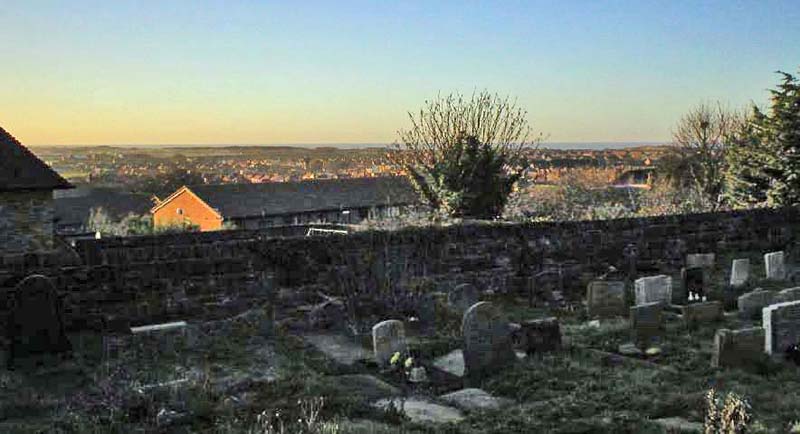 |
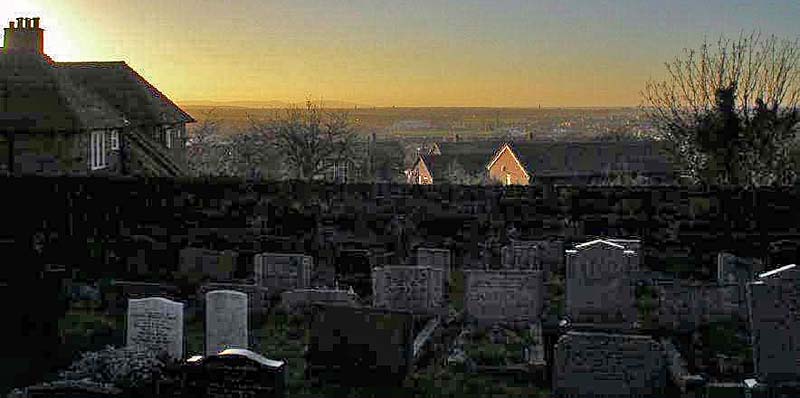 |
|
View From
Bidston Church across Leasowe
and Moreton to Wales |
|
|
Bidston - Courtesy of Google Earth - Image dated: 2005 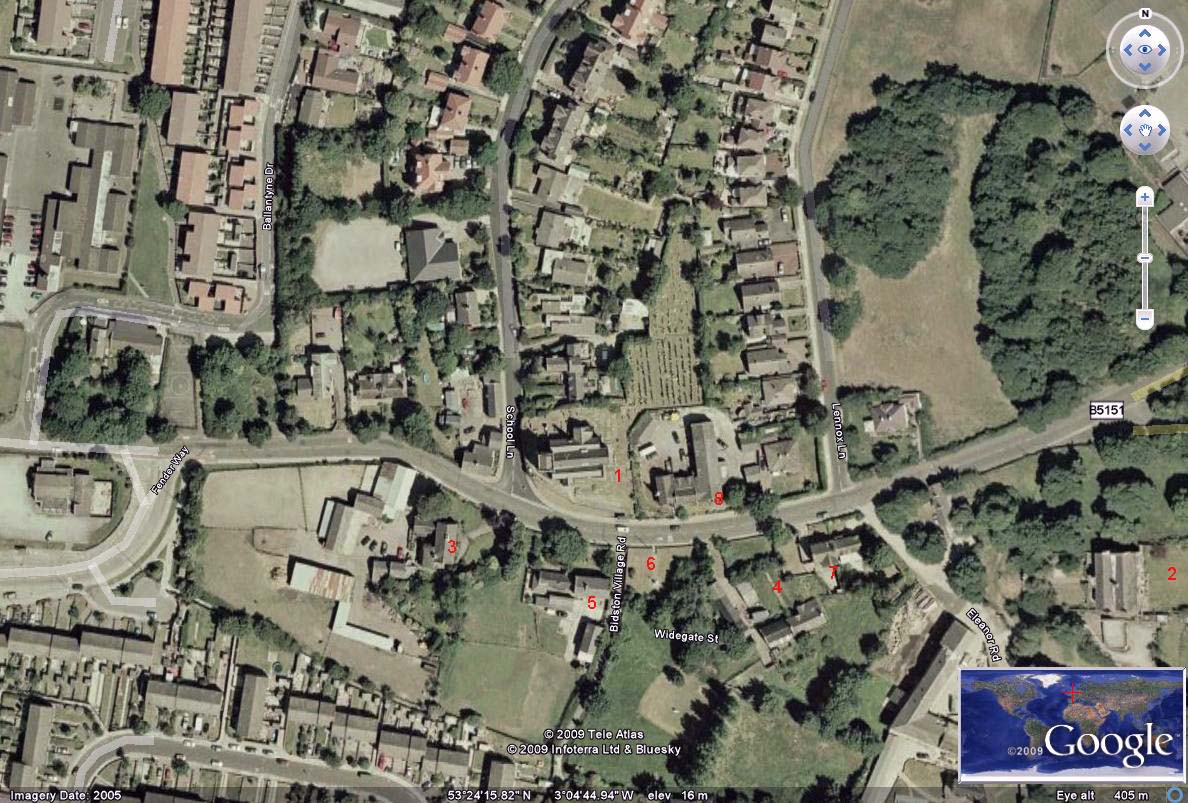 |
|
|
1. St Oswalds' Church 2.
Bidston Hall 3. Church Farm
4. Yew Tree Farm 5. Ivy Cottage 6. War Memorial 7.
Former site of old Village Shop 8. The Buttressed 'Tithe' barn
Bidston Region Map 1945
Bidston Area 1945. note 'toll bridge' on Wallasey Pool, that was the Penny Bridge. Race course on Bidston Moss. On the Hill itself is marked the Observatory, the Mill, and at the southern end, the Victorian Water Works, still there today. Note the total lack of housing on or near the Hill unlike today. Above Bidston and to the right is the North End, rows of houses neatly stacked off the Hoylake Road. Poulton had its own railway station back then. Visible above the Penny Bridge. Other stations visible are Bidston, Wallasey Village and Birkenhead North. By Bidston Court the road twisted down the Hill towards Upton and was part of and known as Thermopylae Pass.
|
|
|
Bidston by © Dachlan Cartwright The water fount the noblest Windsor made Will quench us as the gloaming woodlands sigh Across the bridge they call Thermopylae. A spick and spartan mill with silent blades Stands sentinel, as Bidston Hill parades A leonine ridge where observators try To pry the final secrets from the sky Before we purse our ‘pocalypse and fade. Across the Dee in dusk the Clwydians drown. A thousand pinlights prick the Mersey towns. The sun still percolates the Irish Sea And melts old Triton from Titanic’s lee. Thanks hilly ghosts to host our Beat’s brief tenure. Let’s hope this sandstone kramat lasts millennia. |
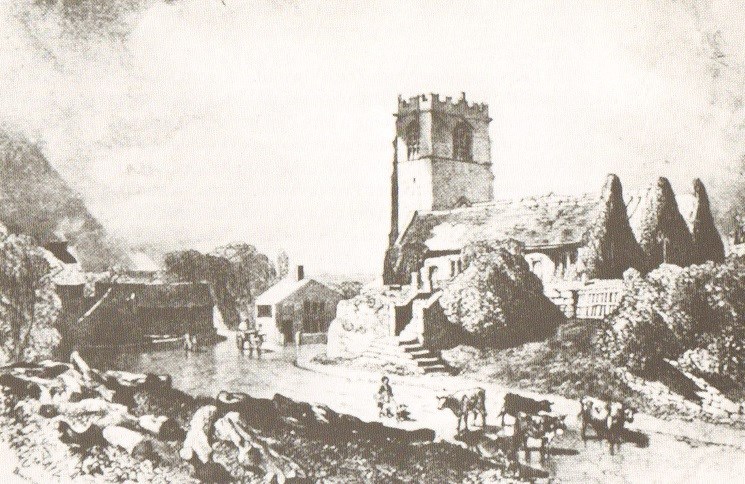 1850 |
|
Artefact discoveries, however, indicates that Bidston was a centre
of early activity prior to the medieval settlement. The majority of
buildings within the village were built during the post-medieval
period. The first detailed survey of the settlement was commissioned
by Lord Kingston in 1665; the buildings shown on the map indicate
that the settlement was principally agricultural farming community
|
The First and Second World Wars left their mark on Bidston with the erection of an army training and reserve camp during the First World War and the establishment of a German Prisoner of War Camp during the Second World War to the north of the village. |
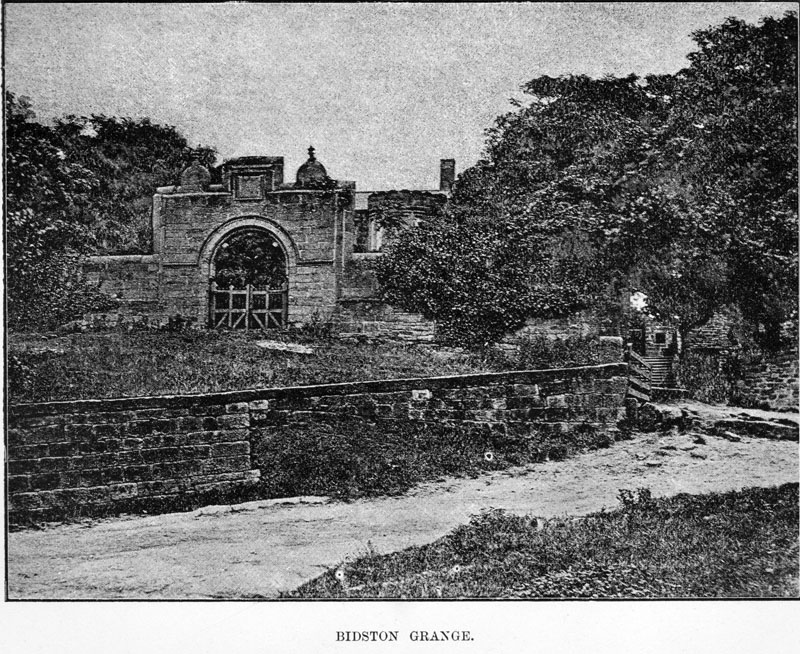 |
the image on the left is taken directly from an 1889 publication and dates from mid 1880s |
|
* Note on Stanleys. This is
the same turncoat family that stabbed Richard III in the back by changing sides
when Richard (Yorkists) was winning the Battle of Bosworth. Richard was beating
Henry's army when the Stanley's attacked the Yorkists from the rear, thereby
turning the course of the battle and changing history forever. It is completely
false that Richard was either a bad king or a murderer of the princes in the
tower. That was propaganda by Shakespeare and the victors.
http://www.wirral360.com/ Virtual Wirral http://www.youtube.com/watch?v=mDH6HhI_P0I&feature=related The Bidston Tunnels
Sources and Reference links
http://www.vwlowen.demon.co.uk/wirral/bidston.htm
My special thanks to Kenneth
Burnley for his permissions: |
|